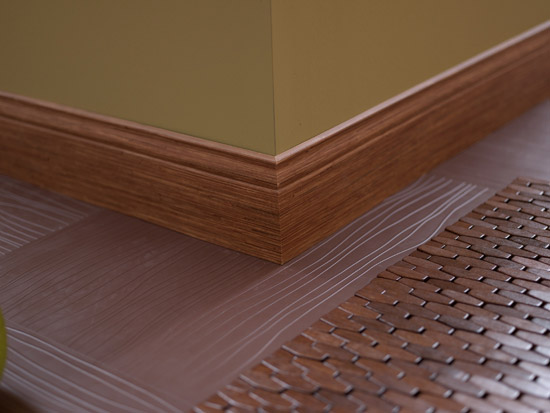New Sustainable and Aesthetic Options in Finishing Borders (Wall Base)
Three Types of Resilient Wall Base
Resilient wall base offers specifiers a unique blend of durability, flexibility, and cost effectiveness. The overwhelming advantages of these resilient wall base solutions may explain why resilient wall base is so commonly found throughout commercial, institutional, and healthcare buildings today. However, there are different types of resilient wall base. In order to specify the right resilient wall base throughout a project, it is important to understand the three different materials most commonly used in resilient wall base, how these materials are different, perform differently and possess different sustainable attributes.
There are three materials commonly used to create resilient wall base throughout the industry. They are thermoplastic vinyl (TV), thermoplastic rubber (TP) and thermoset rubber (TS).
Thermoplastic Vinyl (TV)
Thermoplastic vinyl (TV) is a composite of polyvinyl chloride (PVC) and is thermoplastic, which is a polymer that becomes pliable at high temperatures. This material is often used in the construction industry as electrical insulation, tubing, and even upholstery. Of the three materials often used to create resilient wall base, TV is the least expensive. TV will repeatedly soften when heated and stiffen when cooled and after being heated and cooled many times, the material only exhibits a slight loss of its original characteristics.
Thermoplastic Rubber (TP)
Thermoplastic rubber (TP) is a synthetic rubber compound that may or may not contain vinyl, and does not require chemical vulcanization, a process of treating rubber to improve its elasticity and strength. TP will repeatedly soften when heated and stiffen when cooled and after being heated and cooled many times, the material only exhibits a slight loss of its original characteristics.
Thermoset Rubber (TS)
Thermoset rubber (TS) is the original resilient wall base material. It is made of natural and/or synthetic rubber and it is the wall base material that is often specified by default when architects use legacy specifications. This material does undergo a chemical vulcanization.
Compare the Performance of TV, TP, TS
The American Society for Testing and Materials (ASTM) wrote a performance specification for resilient wall base titled the ASTM 1861 Standard Specification for Resilient Wall Base (ASTM F1861). The specification details dimensional and performance requirements that include color stability, flexibility and chemical resistance. In the ASTM performance specification, all three materials TV, TP, and TS are identified as acceptable, with no differentiating statements on where certain materials are better suited.
 |
The ASTM performance specification for resilient wall base recognizes TV, TP, and TS wall base materials as acceptable. Photo courtesy of Tarkett |
Wall base made from TV, TP and TS are similar in many ways. All of the materials give the wall base the flexibility to conform to variations in the wall or floor surface. They offer excellent chemical resistance and great color stability. They also meet the ASTM F1861 dimensional and performance standards as outlined.
But TV, TP and TS are different materials that do, in fact, perform differently. Some of the differences are aesthetic. For example, the TS surface provides a predominately matte finish, while the TP wall base offers a surface that is smooth and consistent. Some of the differences are much more critical. For example, different types and brands of wall base can perform dramatically differently when the room is filled with fire and smoke.
Fire Resistance / Fire Rating
The fire resistance/Class rating required for wall base used in certain applications is determined by a number of factors, including, but not limited to:
– The version of the International Building Code (IBC) that has been adopted by the state in which the job is being done. Across the United States, different states have adopted different versions of the IBC.
– Any local codes which exceed or supercede the requirements of the IBC.
– The height of the wall base being specified. Depending on the height, a different test may be required, i.e. critical radiant flux, versus flame spread index.
– The area of the building in which the wall base is being installed. Typically, emergency exit ways have a more stringent requirement for fire resistance than does a conference room which has sprinklers.
For example:
• The state of Maryland, has adopted the 2012 IBC. The 2012 IBC requires that interior floor-wall base that is 6 inches or less in height shall be tested for critical radiant flux in accordance with NFPA 253 (ASTM E-648), and the rating shall not be less than Class II. Where a Class I floor finish is required, the floor-wall base shall be a Class I (highest).
• For floor-wall base that is over 6 inches in height, but less than 10% of the specific wall area, the 2012 IBC requires that it is treated as interior trim, which has a minimum Class C flame spread and smoke developed index when tested in accordance with ASTM E-84 (UL 723).
• New York City has its own building code which supercedes the 2006 IBC which has been adopted by the state of New York. The NYC building code has a much more stringent requirement for flame spread & smoke developed index for emergency exit ways than even the latest version of the IBC.
This is not intended to be a comprehensive discussion of fire resistance/fire rating for wall base, but simply a demonstration of how many different factors come into play when selecting a wall base to meet the requirements. It is very important, for each project, to know what codes apply to that location and which products meet those requirements. Each manufacturer publishes the Class ratings for each of their resilient wall base products. Keep in mind that even within each type of wall base (TV, TP & TS), different manufacturers may have a different Class rating.









